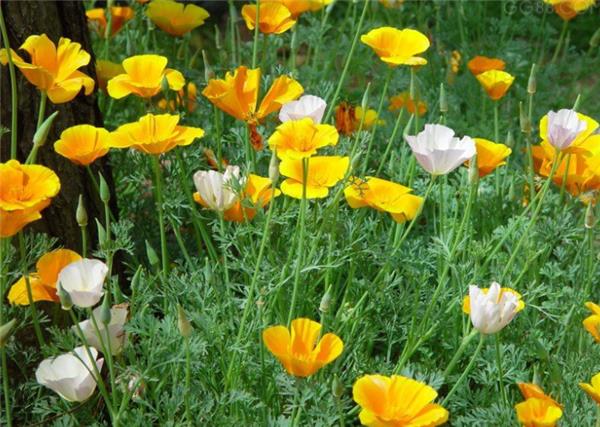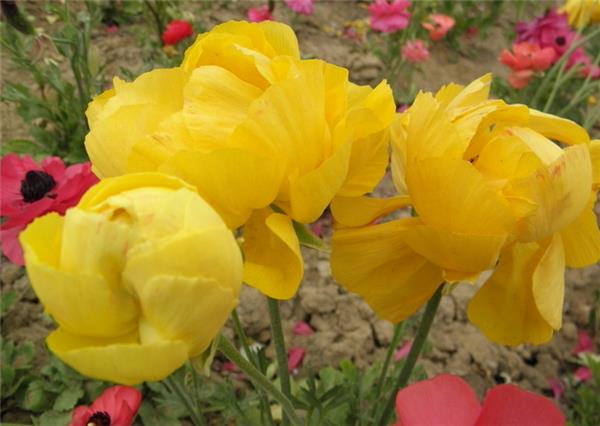How do you know how to grow a flower?
Artemisia mandshurica is a beautiful flower, its stems and leaves are green and a little gray, and the flowers are bright and lovely. At the turn of spring and summer, the lawn in front of the house is often seen with flowers and grasses, and some are planted into flower belts, adding vitality to the house. Now let's take a look at Lingcao.

First, the introduction of flowers and grasses.
Artemisia mandshurica is a perennial herb, which is often cultivated for one or two years. Strong cold resistance, like cold and dry climate, not resistant to wet and hot, hot summer in a semi-dormant state, often withered, and then germinated after autumn. It is a good material for flower belt, flower diameter and potted plant, and can also be used for lawn cluster planting. Hualing Prairie is produced in California, USA. More cold-resistant, like cold, cool and dry climate, not easy to wet and hot, should be loose and fertile, good drainage, upper layer deep sandy loam, but also barren soil. Perennial herbaceous flowers are often cultivated in 2012. Artemisia mandshurica is the state flower of California, also known as California poppy, and it is also known as ginseng and Jinying flower. Flowering lasts from spring to early summer, with flowers blooming in sunny days and closed in cloudy or evening days. The colors are scarlet, rose, milky white, orange, yellowish and so on. Its valve has four, the outer edge shows wave wrinkle. Most wild turquoise plants have yellowish, orange or cream flowers.

2. Cultivation techniques of Rabdosia mandshurica
1. Key points of training
Attention should be paid to the cultivation of Ligusticum chinense.
① is fleshy, monotonous and afraid of waterlogging. In the rainy season, the ground should pay attention to timely drainage, potted plants should be properly watered, should be dry rather than wet, to avoid black erosion of the root neck.
② because Rabdosia frutescens is a taproot plant with long main roots and is not resistant to transplanting, so it is appropriate to direct seeding seeds in the pot.
③ plants sown in spring blossom in summer, but their growth and flowering are usually not as good as those sown in autumn. Therefore, sowing should be carried out from August to September, and the suitable temperature for germination is 15 ℃ 20 min. If the sprouting is irregular and the emergence of seedlings is dense, appropriate seedlings are needed. The planting distance is 20ml / 30cm, the planting site should be high and dry, and the drainage should be good. During the growing period, we should pay attention to loosening the soil and weeding, and cold prevention measures should be taken to spend the winter in the open field.
After the ④ pericarp turns yellow, it should be harvested in the early morning, otherwise the capsule will crack on its own, resulting in scattered seeds.

two。 Daily management
Autumn
After the sowing seedlings have been restored for a period of time, it is necessary to quickly keep up with the management of fertilizer and water. Fertilizer and water management circulates in the order of "Huabao"-"Huabao"-Qingshui-"Huabao"-"Huabao"-clear water-with an interval period of about 1-3 days, and shorter intervals in winter and spring during sunny days or high temperatures, and longer intervals or no watering during rainy days or low temperatures.
Winter
Although it continues to grow, low temperatures will slow its growth rate, require little fertilizer and water, and even control fertilizer and water.
Spring
After the temperature rises, the growth recovers rapidly, and gradually enters the flower bud differentiation stage and flowering stage, which requires a lot of fertilizer and water. Fertilizer and water management cycle in the order of "Huabao"-"Huabao"-"Huabao"-clear water-with an interval period of about 2-4 days, shorter intervals in sunny or high temperature days, longer intervals or no watering in rainy days or low temperature periods. After entering the fruiting stage, stop the supply of fertilizer.

3. Pruning
In the process of flowering, cutting off the residual flowers with three leaves can prolong the flowering period.
4. Fertilizer and water management
Like other grass flowers, they have more requirements for fertilizer and water, but they are most afraid of random fertilization, concentrated fertilizer and partial application of nitrogen, phosphorus and potassium fertilizer, and are required to follow the two fertilization principles of "frequent application of light fertilizer, less fertilizer and more times, complete nutrition" and "dry and wet, dry and dry. Water", and after fertilization, leaves and flowers should be kept dry at night.
The above is the relevant knowledge of Hua Lingcao. I hope I can help you.
Related
- Wuhan Hospital Iron Tree Blooming Result Was Instantly Frightened by the Gardener Master
- Which variety of camellia is the most fragrant and best? Which one do you like best?
- What is the small blue coat, the breeding methods and matters needing attention of the succulent plant
- Dormancy time and maintenance management of succulent plants during dormancy
- Minas succulent how to raise, Minas succulent plant pictures
- What are the varieties of winter succulent plants
- How to raise succulent plants in twelve rolls? let's take a look at some experience of breeding twelve rolls.
- Attention should be paid to water control for succulent plants during dormant period (winter and summer)
- Watering experience of twelve rolls of succulent plants
- Techniques for fertilizing succulent plants. An article will let you know how to fertilize succulent plants.



